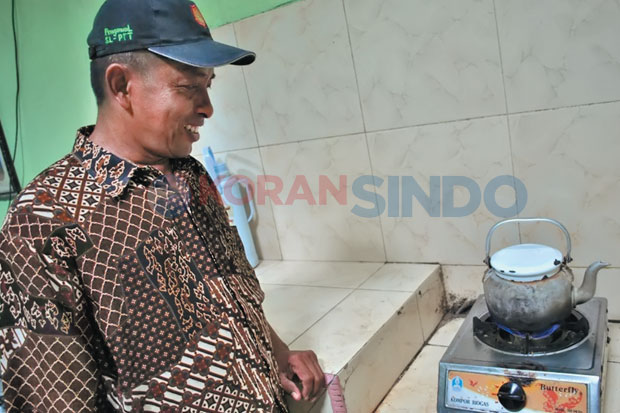
Tugiyo shows the colour of the biogas flame which is more defined compared to those produced by LPG.
KORAN SINDO, BANTUL – There are not that much difference between Tugiyo’s residence and other houses in Gulon Hamlet, Srihardono Village, Pundong Subdistrict.
From the outside, there are almost no activities or striking building characteristics which indicate that the house is equipped with biogas network or installation supplied by the manure of the cows that he raises. Perhaps the one that makes the difference is the presence of cow shed in the side of the house with two cows inside. Whereas Gulon Hamlet also has communal cow shed in which the purpose is to allow cattle owners to keep their animals in the facility.
Tugiyo purposely build the shed and raises his cows on the side of his house. The reason is simple, he just wants to utilise the manures to produce the biogas for his domestic cooking needs. That is why he keeps his cows which he bought from Merapi’s volcanic eruption victim at the side of his house. He also built the biogas installation at the very place.
According to Tugiyo, he was inspired by the Head of Tangkil Hamlet which also built his biogas installation which relies on the supply of cow manures. Tugiyo said, back in 2010, he visited a place in Tangkil Hamlet which at the time received an assistance from Domestic Biogas (BIRU) NGO to buid a biogas installation which relies on a supply of cow manures
Upon returning from Tangkil, he then had a desire to build the same reactor installation with the one in Tangkil Hamlet by purchasing two cows. “I was attracted to build one, as I thought that it will support my endeavour,” he said, yesterday.
After purchasing the cows, he then acquired various materials necessary such as 1,000 red bricks, 26 bags of cement products, as well as several iron pipes. Total amount that he spent to buid biogas reactor in the forms of a dome with 3 meter diameter and 1.5 meter depth was Rp 2.5 millions.
Nothing was too difficult in building a biogas reactor, as all it takes is an underground air tight manure collector and pipe installation to distribute the methane produced inside the reactor. As of that day, he no longer had the need to purchase LPG which he normally consumed between 3-4 tanks of 12-kilogram tank capacity on a monthly basis.
By utilising the gas produced by the cow manures, his business in producing organic drink for those wit heart and diabetic health issues becomes even more promising. The fuels needs to roast the raw materials which normally are required in significant amount are gone, except when there is a specific requirements to use firewood as requested by his customers. “When there is a specific request by the customer in which the raw materials have to be roasted with firewood, only then I spend my money to purchase firewood,” he said.
The repulsive feeling is not there when he prepared the food cooked by a biogas fuel formed out of cow manures. The taste is equally delicious with foods cooked with LPG. He is no longer worried to think about the price of 12-kg capacity LPG tank which constantly fluctuated or the scarcity of 3-kg capacity of LPG which strangles the community.
Every moment, every time, he is free to cook without having to worry on running out of fuels. Since 2010 up to now, he has faithfully utilised the biogas formed out of cow manures for his domestic cooking needs. Various kitchen appliances that he often uses to cook last even longer and do not easily collect dirts.
In fact, the gas stove that he uses was the gas stove provided by the government during the kerosene to LPG conversion programme. “Since the beginning the gas stove and the hose connected to the installation have never been repaced,” he explained. He admitted that he is satisfied that he can continue to operate his biogas installation.
Other than its capability to produce the gas for cooking needs, the sludge excess produced by the reactor turned up to be something that can benefit him as a farmer. The production level of his crops are a lot higher in comparison to using chemical fertilisers and organic fertilisers normally used by other farmers. He is satisfied as his achievements exceed those of the Head of Tangkil Hamlet. He learned that the biogas installation in Tangkil Hamlet which was used as a model is no longer in operation. The organic fertilisers produced as the excess of biogas installation reactor at his place indeed have more advantages in comparison to other organic fertilisers.
The fertiisers with the cow manures as the raw materials have the methane content separated thus the it has higher capability to fertilise the soil in comparison to other type of fertilisers. Not only that, this fertiliser is not too hot that it is safe to use. “Often directly sprinkling the manure to the farm land lead to the crop failures as the heat is still there. With this one, as the methane has been remove, thus the heat is no longer there and it is safer to use,” he uttered.
The Head of Pollution Control Department and Environmental Documentation of the Office of Environment at Bantul Regency, Priya Haryanta, revealed that his party indeed strives to expand the number of biogas installations in the communal sheds belonging the community. Today, there are only around seven biogas installation in Bantul Regency, subsequently two in Sedayu, three in Kasihan, and two in Pajangan.
“Our target, is to install the reactor in each hamlet. However, due to our limited budget, we can only build between 3-4 installations annually, thus the growth is very slow,” he said.


